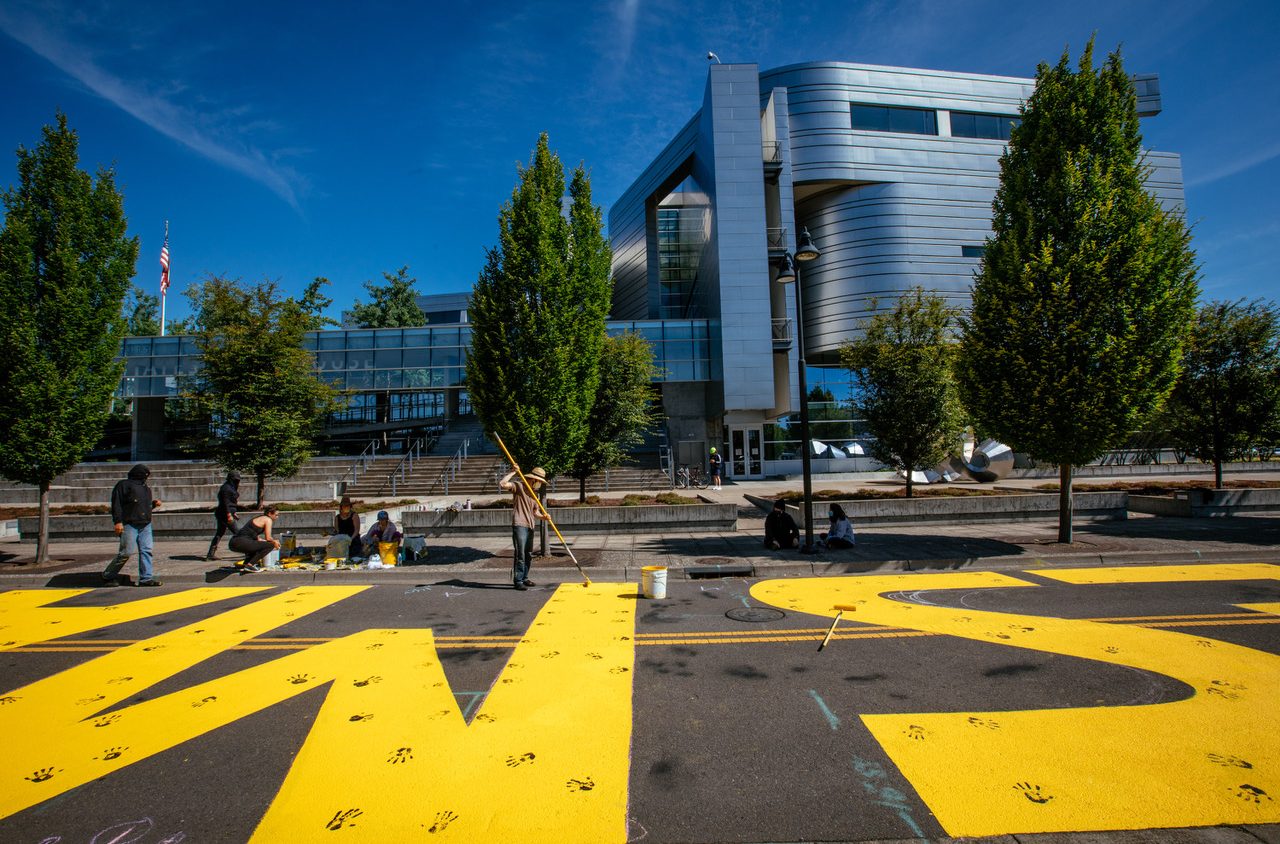On the morning of Juneteenth, a group of people met in front of the Wayne Morse Federal Courthouse at 5 am and began outlining letters for a street mural. They call themselves the Black Indigenous People of Color (BIPOC) Art Collective, and they came to paint.
The sun was hardly up, the light hidden by a nearby building. A little over an hour later, more people joined and began filling the letters with bright yellow street paint so that when it was finished it spanned across the width of the street and read:
Black Lives Matter.
After nearly a month of protesting in Eugene, the Black Lives Matter movement has kept up its momentum across various activist groups. The mural kicked off a weekend of Juneteenth events. Several days later, Springfield residents and others held a rally in support of the Springfield Police Department, but they were met with counter Black Lives Matter protesters, while the police stood by in riot gear.
When members of the BIPOC Art Collective decided that they wanted to paint the street mural, they had only just received permission from the city, which approved their permit application the night before. With the permit, they got to work, and dozens of people painted the letters throughout the morning.
One of the painters, Sean Goddard, says the group wants to create art pieces that allow BIPOC artists to shine.
“That’s our long-term goal,” he says. “We didn’t expect to get the permit.”
Then, that night, someone drove through the mural, streaking a wavy pattern of black tire marks through the middle of the words. The vandal was later identified and caught, according to Eugene police, but the BIPOC Art Collective fought back. Goddard says that when he discovered the vandalism the next morning, he immediately took white paint from his truck and placed white hand prints over the defacement.
On Sunday, more people added to the mural by creating a rainbow of handprints across the tire marks, to represent the LGBTQ community and PRIDE month.
Madeliene Smith, a member of the Black Led Action Coalition (BLAC), says she wasn’t surprised when the mural was vandalized. “I wasn’t super surprised,” she says. “All I could think is that it was white fragility.” She adds that the vandalism created the perfect opportunity to incorporate pride month and show that black LGBTQ lives matter, too.
On Monday, June 22, after the mural was enhanced, Springfield residents gathered downtown to show support for the Springfield Police Department. They came wearing blue and waving American flags, and some were even holding large guns. A counter protest from the Black Lives Matter movement met the pro-police marchers in front of City Hall.
Several fights broke out during the demonstration, including a pro-police rallier tackling a BLM protester. At one point the SPD stepped in to break up some shoving, leading to the arrest of Elizabeth Deffenbaugh, a BLM protester.
As tensions grew, the SPD sent in officers in riot gear, who stood by watching things unfold. The Black Lives Matter protesters eventually moved toward the police shouting “Springfield has killer cops” and “ACAB! All cops are bastards!” until the officers retreated.
The group, followed by a few angry pro-police protesters, walked around several blocks of the city before coming to the Springfield Municipal Jail and marching around its perimeter while police skirted the building in riot gear.
After the rally ended, the remaining protesters celebrated, saying they were victorious in scaring off SPD and the pro-police marchers, and promised to continue taking action.
Meanwhile, the mural on 8th Avenue in Eugene still displays its original message, artfully enhanced by the rainbow of handprints.
“They say a picture is worth a thousand words,” Goddard says. “When you have a thousand hands it’s like a million words. Each hand has a different story.” ν
